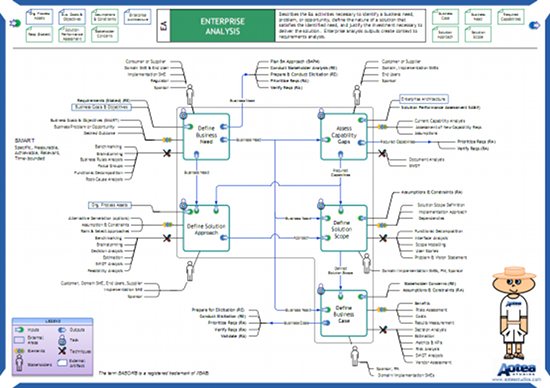The BABOK: Enterprise Analysis
This is the third post in the Beachcamp series. This post is about the Enterprise Analysis section of the BABOK.
Beachcamp: Day 3
Enterprise Analysis (EA) focuses on several areas:
- identification of the business need
- understanding of the current state of an organisation
- understanding of the existing information landscape
- definition of gaps in capabilities
- definition of an approach to a solution and solution scope
- support in developing a Business Case.
Engaging business stakeholders in requirements elicitation activities helps specify the business problem. Enterprise Analysis invokes tasks from Requirements Elicitation and Requirements Analysis when it is required. It happens because the accurate definition of the business need is only possible through communication with the stakeholders.
The expressed high level requirements have to be analysed and prioritised to ensure that the requirements are clearly separated from wishes. Assumptions and constraints related to solution scope are expressed upfront to support the development of the business case.
EA feeds information about the current business landscape and long-term business objectives into BA Planning. Several disciplines facilitate obtaining this information: enterprise architecture, service operation and service help desk (ITIL), business process management (BPM).
The identified current state serves as a baseline for defining a gap between the existing and required new capabilities.
Nowadays projects often combine changes to business processes, software packages, introduction of new business services and even new models of operation. Process mapping and the enterprise architecture framework both facilitate gap analysis. They also help in defining scale of possible changes and identifying business rules governing the existing processes.
After the required capabilities have been specified, it is time to define a solution approach which should be aligned with the project approach to ensure effective execution of the project.
The defined solution approach and required new capabilities enable the definition of solution scope. Solution scope should be aligned with project scope.
The business case is the output of EA. It specifies the business need, required new capabilities, approach to the realisation of the specified new capabilities, project and solution scope, time and cost estimations, assumptions and constraints, and finally justification of feasibility to undertake the project.
Below you’ll find a chart which summarises the enterprise analysis section of the BABOK®.

New! We have published a new book: A Navigator to Business Analysis.
Over 400 pages of practical, useful material will help you build your skills and advance your career! Find out more and get free excerpt.
Free course: BABOK 3 Navigation Maps
Subscribe and get an overview of the knowledge areas in BABOK 3. (Very occasionally, we may let you know about discounts and specials).
